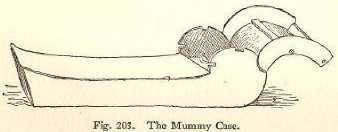Bill's "Mummy Case."
Description
This section is from the book "The Scientific American Boy", by A. Russell Bond. Also available from Amazon: The Scientific American Boy.
Bill's "Mummy Case."
Our second sleeping bag was Bill's own design, and was, in many respects, an improvement on the first, though it looked ridiculously like an Egyptian mummy case. The inner bags were just like those of the first sleeping bag, but as there was no more rubber sheeting in town we had to make the outer bag of enameled cloth, such as is used for carriage curtains.
Out of this cloth Bill cut a piece of the shape shown in Fig. 200 to serve as bottom, sides and ends of the sleeping bag. The bag was sewed wrong side out; that is, the piece was laid with enameled side up, and then the corners were sewed together after painting the scams with white lead. Then a top piece was cut out, of the size indicated in Fig. 201.

Fig. 200. Bottom Piece of Sleeping Bag.

Fig. 201. Top Piece of Sleeping Bag. Fig. 202. Headboards.
The edges were hemmed over a piece of rope, which thus formed a corded edge. Now, with the enameled side of the cover piece turned inward, its edges were sewed to the edges of the first piece. The bag was now turned inside out, so that the enameled surface lay on the outside and the seams turned inward. The corded edge on the cover piece lapped over the sides, forming a watershed.
It was Bill's idea to rig up the flap in such a manner that it would not lie against the face, so that the sleeper could have plenty of fresh air, even in rainy weather. This required the use of two headboards, of the form shown in Fig. 202. The headboards were connected at the bottom by a thin board, and to this framework the sides of the bag were nailed. To the end flap several cleats were nailed, adapted to fit into notches cut in the headboards. The cleat at the end of the flap was laid on edge, as shown, and fitted into deep notches in the headboards just above the edge of the cover piece. This held the flap securely, preventing it from flying open in a heavy wind. At the same time the small space between the flap and the cover piece allowed for an ample supply of fresh air. When using this sleeping bag, if there was any indication of a shower, we took care to have the head pointed to windward so as to prevent entrance of rain through this air space.

Fig. 203. The Mummy Case.

Fig. 204. Sleeping Bag in Use.
Continue to:


